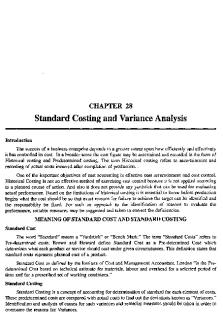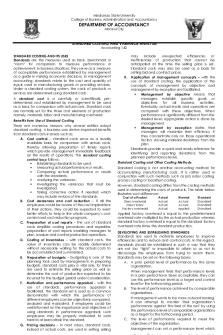Lec 2 Standard Costing and Its Role in Today\'s Manufacturing Environment (Lucas 1997) - Summary PDF

| Title | Lec 2 Standard Costing and Its Role in Today\'s Manufacturing Environment (Lucas 1997) - Summary |
|---|---|
| Course | Advanced Management Accounting |
| Institution | University of Bath |
| Pages | 3 |
| File Size | 89.2 KB |
| File Type | |
| Total Downloads | 83 |
| Total Views | 130 |
Summary
Summary of a mandatory reading given in class. Summaries are required as the final exam questions will be based on a few chosen mandatory readings. ...
Description
Standard Costing and Its Role In Today’s Manufacturing Environment Mike Lucas (1997) Introduction -
-
Division of production system in a number of simple repetitive tasks in order to obtain the advantages of specialisation and to eliminate the time wasted by workers changing from one task to another Standards of performance serve as the basis for financial control o Variances attributed to particular responsibility centres Today’s manufacturing environment is competitive which strives for improving quality, flexibility, lead times, reduced inventories and unit costs o Kaplan et al argued that standard costing is counter-productive in such environment
Case Against Standard Costing In a JIT environment, measuring standard costing variances for performance evaluation may encourage dysfunctional behaviour o Performance measures should motivate managers and workforce towards reducing setup times to achieve economic small batch size as a prerequisite for achieving the lower inventories o Standard costing variances measures benefits from large batch sizes or capitalizing on economies of scale In a AMT (Advanced Manufacturing Technology) environment, the majority of costs are those related to the production facility rather than production volume related costs which is what standard costing is essentially designed to plan and control o Difference between actual and standard fixed costs per unit may simple reflect differences in production volume o Counter-productive as they force managers to focus on the wrong issue o ABCM may be more appropriate, focusing on activities that drive the costs in service and support departments which form the bulk of controllable costs In a JIT/AMT/continuous improvement environment, the workforce is usually, organised into empowered, multi-skilled teams controlling operations autonomously o Feedback is required in real time and in physical terms, periodic standard costing financial variance is not timely nor meaningful enough to facilitate appropriate control actions In a TQM environment, standard costing variance measurement places an emphasis on cost control to the likely detriment of quality o Cost control may be achieved at the expense of critical quality and competitive advantage issues A continuous improvement environment requires a continual effort to do things better, not achieve an arbitrary standard based on prescribed or assumed conditions o Target cost per unit is a market-driven cost that has to be achieved if desired profits are to be achieved o Cost management to consist of both cost maintenance and continuous cost improvement in this competitive, improvement-seeking environment In a largely automated production system, processes are so stable that variances simply disappear
o o
With statistical quality control and automation, emphasis should be switched to product design stage as most costs are effectively committed during this phase Designer controls the design activities using the target cost as an economic guideline
The Case for Standard Costing Basic principle of standard costing variance analysis specifies in advance what should be achieved and then measuring the extent to which it is being achieved -
-
-
-
-
-
Countering dysfunctional behaviour in a JIT environment o Exclude set up times from the labour input side of the equation o Adopt a counter balancing performance indicator which discourages long run decisions o Fixed overhead volume variance admittedly has no relevance for control purposes, not appropriate for decision making o Attitude of senior management to the interpretation of variances Empirical evidence still cites that majority of costs are constituted by direct costs which will usually be volume related o With relational database technology, it may be a realistic option to operate two cost management systems Standard costing variance analysis for volume-related costs ABCM for non-volume related cost Standard variances which provide periodic financial information is still important in work teams o Informing work teams of the financial implications of their activities o Integrated computerised manufacturing and accounting systems can provide financial variance information in real time o Financial variance information facilitates planning and monitoring financial consequences at the senior management level, incorporating an element of parochialism for work teams Over emphasis on cost control being detrimental to quality does not justify the abandonment of cost control o Reinforces the need to measure performance through a range of indicators (e.g. cost, quality, lead times, inventory levels) Even with continuous improvement, essential principle of controlling unit product cost embodied in standard costing is preserved o Kaizen Costing using the actual production cost of the previous year as the basis for comparison o Some production technologies have limited scope for continuous improvement Maintaining engineering standards may be the overriding imperative There is usually considerable scope for cost variability at the production stage o Kaizen is used to encourage continuous improvement by targeting reductions to current unit costs and then comparing actual reductions against these targets
Conclusion -
Basic principle of accounting control embodied in standard costing remains rational o However, constituents of the standard, the variances calculated and interpreted may need to change...
Similar Free PDFs

Character in Todays Reality
- 2 Pages

06 Standard Costing KEY
- 13 Pages

Standard Costing - Copy
- 16 Pages

Topic 3 Standard Costing
- 4 Pages

Testbank Standard Costing
- 30 Pages

Objectives of Standard Costing
- 5 Pages
Popular Institutions
- Tinajero National High School - Annex
- Politeknik Caltex Riau
- Yokohama City University
- SGT University
- University of Al-Qadisiyah
- Divine Word College of Vigan
- Techniek College Rotterdam
- Universidade de Santiago
- Universiti Teknologi MARA Cawangan Johor Kampus Pasir Gudang
- Poltekkes Kemenkes Yogyakarta
- Baguio City National High School
- Colegio san marcos
- preparatoria uno
- Centro de Bachillerato Tecnológico Industrial y de Servicios No. 107
- Dalian Maritime University
- Quang Trung Secondary School
- Colegio Tecnológico en Informática
- Corporación Regional de Educación Superior
- Grupo CEDVA
- Dar Al Uloom University
- Centro de Estudios Preuniversitarios de la Universidad Nacional de Ingeniería
- 上智大学
- Aakash International School, Nuna Majara
- San Felipe Neri Catholic School
- Kang Chiao International School - New Taipei City
- Misamis Occidental National High School
- Institución Educativa Escuela Normal Juan Ladrilleros
- Kolehiyo ng Pantukan
- Batanes State College
- Instituto Continental
- Sekolah Menengah Kejuruan Kesehatan Kaltara (Tarakan)
- Colegio de La Inmaculada Concepcion - Cebu









